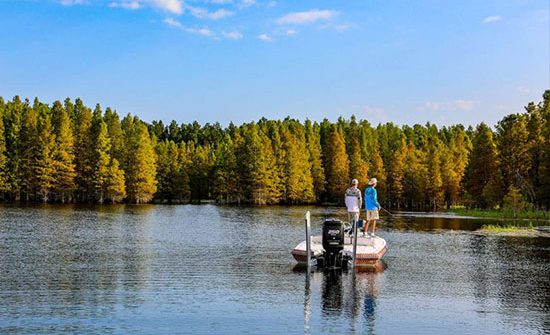Author: Hunter Brant, President of Oakwood Realty Group
Date: November 4th, 2020
 Changes to the deductibility of conservation easements have been discussed by the new presidential administration, however, it is the consensus of the conservation community that the value of conservation easements to environmental stewardship, which many in both parties support, would be hard to overlook when future changes are considered. Regardless, this may add urgency to the minds of many landowners and should be considered when evaluating future plans for your property.
Changes to the deductibility of conservation easements have been discussed by the new presidential administration, however, it is the consensus of the conservation community that the value of conservation easements to environmental stewardship, which many in both parties support, would be hard to overlook when future changes are considered. Regardless, this may add urgency to the minds of many landowners and should be considered when evaluating future plans for your property.
Increase in sales of land with Conservation Easements
The general market trend for recreational and sporting properties has been very strong and seems to coincide with an interest in stewardship and conservation as a win-win. State and Federal investment in conservation purchases has declined recently due to budget restrictions. The traditional use of conservation easements as a donation of rights remains vibrant. As conservation easements have become more commonplace, landowners’ and buyers’ comfort with their use and implications has increased. As these conserved lands change hands more often, the familiarity with them has helped to establish a market for these properties, yielding increased interest, shorter sales timeframes and higher prices, where previously conserved properties were harder to sell and required steeper discounts. This market trend in desirability of conservation properties has coincided with a broader market trend of increased interest for recreational and sporting properties as a retreat and place of quiet enjoyment for a family during the pandemic.
Historically, the primary motivation for placing a conservation easement on land was legacy and land stewardship. The additional benefit of offsetting tax on ordinary income attracts landowners and Buyers that might not have previously been interested. Now the market is recognizing that the landowner maintains most, if not all, of current or desired uses of the land even though the conservation easement is in place.
Increased interest in recreational and sporting properties for ownership and stewardship
“Depending on the facts and circumstances, a conservation easement can be a very useful tool for owners who are not only looking to protect their land in perpetuity but are also looking for a potential tax benefit,” says Morgan Williams, a Family Office CPA in Charleston, South Carolina. “Some of the families that we have worked with have used the charitable deduction from a qualified conservation contribution to offset or reduce the capital gains from their timber operations as well as diversifying out of concentrated equity positions. States have also made conservation easements attractive with various incentives from reduced or exempted real estate taxes to state tax credits.”

For an individual or business owner with reasonable assurance of high taxable income over the next ten to fifteen years, and even a passing interest in owning and enjoying recreational land, the easement is a tremendous tool to acquire, own and enjoy the property while assuring great stewardship for the future and taking advantage of the tax benefits from the donation value of the easement. In the case where personal enjoyment represents a large motivator in the decision to buy, this tool takes on even greater value. For the Buyer, the opportunity exists to purchase a property that fits their needs and desired uses at a discount to market value.
The biggest challenge facing owners of high-quality land today is the increasing cost of owning and maintaining what has traditionally been a non-income producing asset. As families search for alternative revenue sources to offset these costs, oftentimes they place too much pressure on natural resources such as timber. This pressure makes their cash flow unsustainable and decreases the value of the property in the long run. This strategy can lead to the property being broken up or sold outright when the cash flow runs out. The opportunity to divert cash away from income tax payments and toward improvements or maintenance is a win for the landowner. This is one way to generate cash in the form of tax savings without putting additional strain on the natural resources of the property. There is also very little property tax due on conserved land, which further reduces annual expenses albeit small in comparison to operating cost.

According to Justin Park, Ducks Unlimited’s Southern Region Lands Manager “We’re still seeing easements used as an income tax offset strategy. The deductibility rules have never been better at a federal level. There’s also funding for certain types of easements that can help cover transactional hurdles and provide a cash infusion for a land-rich sort of owner who wants to keep their land the same but could use some operational funding to keep that up. A bargain-sale easement is a way to get some cash to set up a management fund or fund capital investments. Not to mention the partnership potential with Ducks Unlimited as an easement holder and all of the technical assistance we can provide to our partner landowners.”
An Example of Conservation Benefits
Disclaimer: The following example is a summary of the conservation benefit equation based on discussions with professionals in this industry, but any client should consult with a lawyer or CPA to review this strategy and how it would affect their own tax situation. The final deductions available to a client will be based on appraisals and therefore cannot be guaranteed.
Suwannee Valley Plantation is a Florida property for sale, currently listed with Oakwood Realty Group. This property contains 1,500 acres of conserved land, is bordered by an existing conservation easement and borders a state forest with frontage on the historic Suwannee River. This makes it an ideal candidate for an easement and legitimizes the conservation use. On the other hand, the owner re-zoned the property several years back to mixed-use zoning, which increases its development potential and the resulting highest and best use value.
The donation value of the easement is the difference between the highest and best use appraisal and the conserved value appraisal. The difference between these appraisals is the donation value to the owner after owning it for a one-year minimum. Multiplying this value by your tax bracket % gives your total potential tax savings. The value of that donation can be used up to 50% in any one year to offset tax on ordinary income and it can be carried forward for 15 years. Potential total tax benefit to the owner in this example could be in the millions over 15 years, depending on how the property is owned and the limits on that individual or entity’s annual charitable deductions. This property also lies in an Opportunity Zone which could further increase the tax benefit if certain conditions are met.
If one could obtain a high-quality recreational property, pay less in income tax, pay lower property tax, use the property and maintain the value of your asset that would be an attractive deal. Even more attractive still is establishing a record of excellent stewardship of the land for perpetuity and preserving it for future generations to enjoy.
The Land Trust Alliance offers a helpful summary of the benefits and intricacies involved in conservation easements for land and we recommend it as a resource to our clients.
We hope this discussion of the changes in the market for conserved land gives landowners and buyers a better understanding of investing in land and leads to more land being protected for future generations. To learn more about the conservation and investment opportunity for Suwannee Valley Plantation contact Oakwood Realty Group President and Broker Hunter Brant.
………
Author:
Hunter Brant, President and Founder
Oakwood Realty Group

